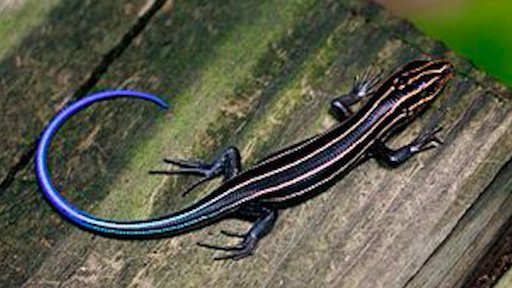
Animals use a startling array of colourations to thwart predators — for camouflage, to warn that they’re poisonous or even to mimic other dangerous creatures. But highly-conspicuous stripes on some reptiles, which should make them more visible to predators, have long baffled scientists. Now researchers from the Indian Institute of Science, Education & Research, Thiruvananthapuram (IISER-TVM) have shown high-contrast stripes running along the length of a lizard’s body can cause a phenomenon called motion dazzle, which hinders predators’ perception of their prey’s speed or direction.
Using human volunteers and a computer game mimicking predator-prey interactions the team showed this effect can redirect attacks away from vital areas like the head and trunk to the tail of the lizard. “Researchers have long been interested in explaining why certain animals possess conspicuous striped colour patterns, which should enhance detection by predators. Our study is the first to explicitly demonstrate that conspicuous striped patterns on vital body parts can indeed divert attacks away towards non-vital body parts,” said graduate student Gopal Murali, the lead author of the study published in the journal Royal Society Open Science.
The authors say this makes evolutionary sense as any attack on the head or trunk is much more likely to be lethal than an attack on the tail. In addition, the tails of many lizard species can grow back after being chopped off and are therefore expendable.
The touch-screen computer game the scientists used to validate their theory, required volunteers to catch prey covered in different patterns — stripes vs. random blotches — on varying parts of the body — head and trunk vs. tail. They found that lizards whose head and trunk sported high-contrast stripes running parallel to the direction of their movement were attacked much more often on their tail than on their upper body, compared to prey with random blotches on their head and trunk.
To confirm the role of motion dazzle the authors used a strategy common in optometry testing called an adaptive staircase paradigm. Volunteers are presented with a fixed-speed target and another with variable speed, which allows researchers to compare the perceived speed of an object against its actual speed. The results showed that the striped patterns caused lizards to appear slower than they actually are, causing attacks aimed at the upper body to land on the tail instead. Murali says this means their research not only demonstrates the role of the stripes, but also explains how the effect is achieved.
“I particularly like how it tests a biologically inspired hypothesis, as this is something that the field hasn’t always focused on. I think it’s great that they have been able to propose a mechanism for this effect, linking up the behavioural ecology with the perceptual experience,” said Anna Hughes, a teaching fellow at University College London, UK, who specialises in animal colouration and visual perception.
Murali concedes that using human volunteers means they must be cautious in assuming their findings apply to animals with different visual systems. “We actually thought of doing the experiment outdoors with real predators, but we could not do it because we could not train the actual birds or other predators of these lizards to exactly attack the head of the animal which had stripes,” he added.
Martin Stevens, an associate professor of sensory and evolutionary ecology at the University of Exeter, UK, complimented the study. “It tests the idea of motion dazzle in markings that are somewhat closer to those on real animals, rather than very artificial patterns as in past work,” he said.
This story is based on a press release from the Science Media Centre India.